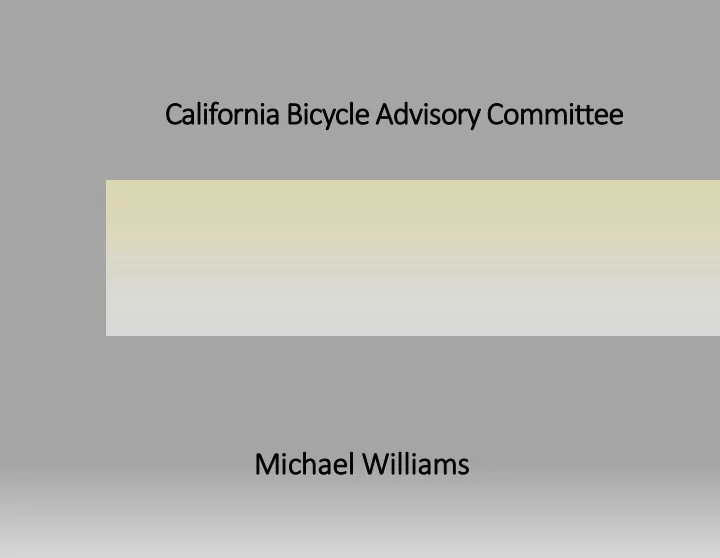

California B Bicy cycl cle A Advi visory C Committee e Advisory Bike Lanes A Path Forward Michael W Williams s
Presentation • Introduction & Benefits • Design Guidance • Current Installations & Case Studies • Challenges • The Path Forward
2
3 Courtesy Toronto Star
4
5 Courtesy Alta Planning + Design
Why Should We Care? ABLs: • Provide bike lanes on narrow roads or roads without $$ • Can provide pedestrian facilities • Provide traffic calming • Are inexpensive to install – only re-striping is required • Reduce maintenance costs, avoid snow removal costs • Are applicable to hundreds of thousands of road-miles • Domestic examples safe at up to 5,000 ADT and 30 MPH
~ 10 DECEMBER 2016 N "' Small Town w ::;: Yield to Bicyclists Motorists must yield to and Rural bicyclists and pedes t rians if present when veh icles traveling in opposite directions meet. Multimodal Networks Advisory shoulders are a new treatment type in the United States and no per formance data has yet been col lected to compare to a substantial body of international experience. In order to install advisory shoulders, an approved Request to Experiment is required as detailed in Section 1A.10 of t he MUTCD. FH WA is also accepting req uests for experimentation with a similar treatment called "dashed bicycle lanes." Advisory Shoulder Advisory shoulders create usable shoulders for bicyclists on a roadway that is otherwise too narrow to accommodate one. US.Department of Tra,spartation Federal Highway Admlnlslratfan The shoulder is delineated by pavement marking and optional pavement color. Motorists may only enter the shoulder when no bicyclists are present and must overtake these users with caution due to potential oncoming traffic. Courtesy Alta Planning + Design 2-17
~ ~ Siting Criteria Speed and Volume 2016 STRMN Guide Most appropriate on streets with low to moderate volumes and moderate • Preferred speed motor vehicles. (ty 25 MPH or less, 3000 ADT or less PRErERRED • Potential 12k w ~ :, 10k Up to 35 MPH, 6000 ADT or less ...J 0 > w_ 8k ...J t- ~ o • Volume – Speed Tradeoff Ict w- > Not Addressed 0 t- o 2k • Bicycle Volumes 10 20 30 40 50 MOTOR VEHICLE Not Addressed OPERATING SPEED (MI/H)
Installations 2017 Survey Paper LESSO I-IS LEARI-IED Advisory Bike Lanes in North America • Survey of 12 Installations • First ABL in 2011 • Considered safe • 5 safety studies Current Installations: 16 – 20 ABLs in North America
12 Photo Courtesy Street Plan Collaborative Hanover, NH Pop. 11,000 • Provided facility for both pedestrians and bicyclists • Reduced speeding issues and vehicle volumes • Increased pedestrian and bicycle volumes Courtesy bikewalkmove.org
12 Photo Courtesy Street Plan Collaborative Courtesy bikewalkmove.org Minneapolis, MN Pop. 400,000 • Bicycle network needed a connector but removal of parking not possible • Urban setting and high vehicle volumes, approx. 5,000 ADT • Lots of public outreach to parties along the street and bicycle community Courtesy bikewalkmove.org
Challenges Challenges • Guidance shortcomings • Ambiguous legal standing • Possible regulatory issues • North American experience is limited • ABLs still unknown to public & many practitioners • No ADA guidance for ABLs as pedestrian facilities • FHWA’s RTE study requirements lack rigor • ABL design more nuanced than appears
The Path Forward The Path Forward • Support experimentation within safe parameters • Work to support & create ABL-enabling legislation • Work to create sound guidance • Support ABL research – TRB RNS, Pooled Funds, etc • Increase public awareness of ABLs • Include ABLs in educational outreach activities • Educate Caltrans local assistance staff • Secure ADA guidance for ABLs as pedestrian facilities • Talk with other DOTs & agencies about ABLs • Encourage FHWA to define requirements for RTE studies
20 THANK YOU! @bikepedx bikepedx@gmail.com advisorybikelanes.com https://lists.coe.neu.edu/cgi-bin/mailman/listinfo/advisorybikelanes Photo courtesy Richard Sparks
Recommend
More recommend